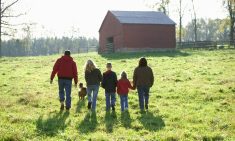OK, so you don’t absolutely have to tweet, but when you see how these farmers are using Twitter to do things that you’d like to do too, you’re going to start wondering
For Stewart Skinner, tweeting is the great equalizer, and lets him go head to head against groups like PETA and the Toronto Humane Society. For Jeff Steiner, it isn’t about that at all. Instead, for Steiner tweeting is all about finally finding a way to make email technology really pay dividends on the farm.
Read Also

What to consider when setting up farm-related business ventures
Things to consider before launching a farm-adjacent side business.
As Twitter morphs from geeky curiosity into a valuable tool on the farm, the only constant seems to be that the benefits are going to the farmers who are finding ways to achieve some very specific objectives with the technology. But those objectives — which range from keeping posted on the latest production and marketing information to trying to influence public opinion — are as different as the farms and the farmers who are setting them up.
For instance, until now consumers have learned about their food from mega-groups, either representing industry or else animal rightists. But with Twitter, individual farmers can present their own personal stories, with even more impact.
“I can’t really go and take out an ad in the GLOBE AND MAIL and get people to hear my story,” says Stewart Skinner, a hog farmer in Listowel, Ont., who tweets at twitter.com/ModernFarmer. “Social media gives us an easily accessible tool to get our message out.”
Without Twitter, Skinner says, it’s tough and maybe impossible for farmers and farm groups to take on the $33 million annual budget of PETA. With Twitter, it’s more of a fair contest.
“Social media has just opened up a door that allows farmers to go on an even playing field with the people that they are trying to counter,” said Skinner. “This is really in my mind the first time when we’ve ever been at least on the same footing, so that we can equally spread our message and let a person make their own informed decision about what they think surrounding animal agriculture.”
Twitter is a social media phenomenon as more Canadians rush to write their own “tweets” (text-based posts of up to 140 characters) and also follow other users’ messages. Unlike too many emails, tweets are short, digestible, and practical.
In other words, says Jeff Steiner of Reesor Seed &Grain, a farm supply business servicing the York and Durham areas in central Ontario, tweets can be ideal communication technology for farmers to talk to other farmers, to their suppliers and to their advisers, not just to the outside world.
“A tweet is only 140 characters, so it forces you to be very precise and to the point,” says Steiner.
Steiner, who tweets at twitter.com/ScoutingFields, opened his
account last fall after his 16-year-old son made him a believer that Twitter could be a good resource tool for farmers.
“There are a lot of people that use it for personal things and shoot out whatever they’re thinking about,” Steiner says. “What I’m focusing in on is strictly information.”
Steiner’s account is aptly titled “Scouting Fields” as he includes a good deal of crop disease information with links to pictures.
“I want it to be something more than just posting prices or talking about the Canadian dollar,” says Steiner. “I want something that can actually be a visual for guys to see, like anthracnose on stalks, and they can actually bring that up and see what kind of symptoms that particular disease is doing to the crop.”
His Twitter account is tied to the scoutingfields.wordpress.com website, where he blogs further about the topics on his tweets, and also offers links to suppliers and resources like the Weather Network.
This winter Reesor — which also has a million bushel elevator that receives corn, soybeans and wheat in Port Perry — has worked on a website to give people even more in-depth information, including posted elevator prices and a link to DTN.
Meanwhile, freelance writer and journalist Lilian Schaer started her account ( twitter.com/foodandfarming) to help bring more people to her blog at www.foodandfarmingcanada.com.
“The blog is my primary venue for writing and sharing information,” Schaer says. “I use Twitter to drive traffic back to the blog and promote the blog, but also interact with people online and share links and other interesting things online on other websites.”
Schaer uses Facebook as well, with a personal account to stay connected with friends, and another for the blog.
“Not everybody is on Twitter or on Facebook, so what I do is something that a lot of people do,” says Schaer. “I try to have presence in a variety of different social media venues to try to ultimately reach as many different people as possible.”
Lethbridge, Alberta farmer Shaun Haney ( twitter.com/Shaun Haney)also sees Twitter as a means to discuss common issues with people who share similar interests. “It’s a good way to broaden your network and it’s a great way to get information,” Haney says. He also has a website at www.realagriculture.com, which focuses on crop and livestock production.
And believe it or not, even cows are getting into the Twitter act.
“Where’s that farmer? I just pumped out 15.9 kg for him. I need a pat on the head,” tweets twitter.com/FreerideSpeedy on twitter.com/thegoodone/cows-on-twitter.
twitter.com/Montgomerymae informs
readers, “I just squirted 18.2 kgs of milk out of my teats in 3:40 seconds. What did you do today?”
It’s all a part of an experiment headed by Marcel O’Gorman, director of the critical media lab at University of Waterloo, along with dairy farmer Chris Vandenberg, an eager young farmer in Brant County, southwest of Toronto. It takes data that a robotic Voluntary Milking System (VMS) provides from a dozen cows and automatically transforms it into tweets.
“We were very interested in the question of whether the cows are more free than they were before, etc., and how the machine affected the relationship between the farmer and his cows,” says O’Gorman, who was raised on a vegetable farm in LaSalle, Ont., just south of Windsor.
As Twitter became hot, the media team figured it would be an ideal outlet to also give people a better sense of where milk comes from and the kind of high tech processes that are involved in farming.
“People in Waterloo like to think of themselves as the Massachusetts Institute of Technology (MIT) of Canada,” says O’Gorman. “Really the tech entrepreneurs of the region are the farmers. They’re doing some amazing things.”
Now every time one of the dozen cows approaches or goes in the pen, a prefab message goes out, O’Gorman says. “There are several messages that can be chosen at random by the computer so it makes it look as if the cow is actually talking.”
A number of results have come out of the project. For one, they’ve found that the cows do in fact seem happier under the VMS arrangement, meaning the robotic milkers have fulfilled their promise of boosting milk production and lowering rates of infection.
The researchers also discovered people care about where their milk comes from. A number of newspaper articles about the unique program have appeared in Canada and the U.S., and have created public discussion and awareness about how technological advances could lead to increased freedom and happiness for an animal.
The experiment also renewed the farmer’s relationship with his cows.
“With these robotic systems… you really have a different relationship with your cows than you did when you were dealing with a milking pen and you had to lead them one by one into the pen,” says O’Gorman. “So this gives Chris a very different way of looking at his cows and a different way of looking at the raw data that’s coming out of his server.”
It has also become an educational tool, as a number of visitors come to the barn, and Vandenberg goes into classrooms to teach kids about dairy farming.
A half hour away, Skinner has made some converts by engaging consumers via Twitter, even when the consumers seem to have attitudes that other farmers would say are too extreme to change. In messaging with a raw food vegan, for instance, Skinner learned she and her vegan friends had assumed that pigs were raised in incredibly dirty conditions, and that they were abused and slaughtered inhumanely.
“They were under the assumption that when animals were slaughtered, they were completely conscious,” Skinner says, adding that he explained to her that by law, the animal must be stunned beforehand. “So little things like that that the farming community assumes everybody knows can be a light-bulb moment for that urban consumer.”
Videos released by animal rights groups unfairly paint every farmer with the same brush. Yet Skinner says Twitter can restore the balance by showing farmers who care about their animals, about the environment, and about the food they produce.
“Social media is a great way for you to get your side of the story out because you’re not relying on the media or government or somebody else to be the filter,” agrees Schaer.
Twitter lets farmers interact directly with consumers, something that has been missing since the days people went to market everyday, she says. Whether it’s on Facebook, Twitter, or with a blog, non-farmers are getting acquainted with and engaging the growers.
Trevor Herrle-Braun, who runs Herrles Country Farm Market just west of Waterloo, says he tries to educate his urban customer base about what actually happens on his farm by tweeting at twitter.com/HerrlesMarket from wherever he’s working, even when he’s sitting on his tractor spraying or planting.
“It puts a face behind the business,” Herrle-Braun says. “People saw our farm market as just another business, they didn’t see the hours that we put into getting stuff from field to shelf and how fresh it is.”
Twitter also had a direct impact in avoiding a sales catastrophe. One weekend, a road leading to the market was going to be closed, forcing customers to take an 11 km detour. He tweeted about it, a regional councillor ended up receiving scores of complaints about the closure from customers, and she made sure a lane would remain open.
Using Google Analytics, which allows one to measure one’s social networking sites, Herrle-Braun discovered just how widespread his messages were.
“The one day I checked it, 50 per cent of my comments were re-tweeted and that day I reached an audience of something like 34,000 people. Where else can you reach that amount of people that quickly?”CG
———
“Social media has just opened a door.” — Stewart Skinner
———
Twitter is too powerful to leave to non-farmers, Skinner says. It produces too many “light-bulb moments.”















